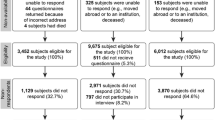Abstract
Background: Limited information exists regarding the natural progression of health-related quality of life (HRQOL) in the general population, as most research has been cross-sectional or has followed populations with specific medical conditions. Such norms are important to establish, because the effect of any intervention may be confounded by changes due to the natural progression of HRQOL over time. Methods: Participants were randomly selected from 9 Canadian cities and surrounding rural areas. Changes in the eight domains and 2 summary component scores of the Medical Outcomes Study 36-item short form (SF-36) were examined over a 5 year period (1996/1997–2001/2002). Mean changes were calculated for men and women within 10 year age categories. Multiple imputation was used to adjust for potential selection bias due to missing data. Results: The baseline sample included 6539 women and 2884 men. Loss to follow-up was 17% for women and 23% for men. Mean changes tended to be small, but there was an overall trend towards decreasing HRQOL over time. Changes were more pronounced in the older age groups and in the physically oriented domains. Younger age groups tended towards small mean improvements, particularly in the mentally oriented domains. Large standard errors suggest that on an individual level, large improvements in some participants are balanced by large declines in others. Conclusion: In general, the HRQOL of Canadians appears relatively stable over a 5 year period. However, care should be taken when assessing HRQOL longitudinally in certain age or gender groups, as changes associated with an intervention can potentially be confounded by the natural progression of HRQOL.
Similar content being viewed by others
References
JE Ware SuffixJr KK Snow M Kosinski B Gandek (1993) SF-36 Health Survey Manual and Interpretation Guide The Health Institute, New England Medical Center Boston
JE Ware SuffixJr M Kosinski SD Keller (1994) SF-36 Physical and Mental Summary Scales: A User’s Manual The Health Institute, New England Medical Center Boston
JE Ware SuffixJr. (2000) ArticleTitleSF-36 health survey update Spine 25 3130–3139 Occurrence Handle11124729
EM Andresen AR Meyers (2000) ArticleTitleHealth-related quality of life outcomes measures Arch Phys Med Rehab 81 IssueID12 Suppl 2 S30–45 Occurrence Handle1:STN:280:DC%2BD3M%2FnslyltA%3D%3D
A Garratt L Schmidt A Mackintosh R Fitzpatrick (2002) ArticleTitleQuality of life measurement: Bibliographic study of patient assessed health outcomes measures Br Med J 324 1417–1421
EA Bayliss MS Bayliss JE Ware SuffixJr JF Steiner (2004) ArticleTitlePredicting declines in physical function in persons with multiple chronic medical conditions: What we can learn from the medical problem list Health and Quality of Life Outcomes 2 47–55 Occurrence Handle10.1186/1477-7525-2-47 Occurrence Handle15353000
H Hemingway M Stafford S Stansfield M Shipley M Marmot (1997) ArticleTitleIs the SF-36 a valid measure of change in population health? Results from the Whitehall II study Br Med J 315 1273–1279 Occurrence Handle1:STN:280:DyaK1c%2FltFCqsQ%3D%3D
Hopman WM, Berger C, Joseph L, Towheed T, vanden Kerkhof E, Anastassiades T, Cranney A, Adachi JD, Ioannidis G, Poliquin S, Brown JP, Murray TM, Hanley DA, Papadimitropoulos M, Tenenhouse A the CaMos Research Group. Stability of Normative Data for the SF-36 Health Survey: Results of a three-year prospective study in middle-aged Canadians. Can J Public Health 2004; 95: 387–391.
G Mein P Martikainen H Hemingway S Stansfeld M Marmot (2003) ArticleTitleIs retirement good or bad for mental and physical functioning? Whitehall II longitudinal study of civil servants J Epidemiol Commun Health 57 46–49 Occurrence Handle1:STN:280:DC%2BD3s%2Fitlegtw%3D%3D
WM Hopman T Towheed T Anastassiades A Tenenhouse S Poliquin C Berger L Joseph J Brown T Murray JD Adachi D Hanley M Papadimitropoulos InstitutionalAuthorName the CaMos Research Group (2000) ArticleTitleCanadian Normative Data for the SF-36 Health Survey Can Med Assoc J 163 265–271 Occurrence Handle1:STN:280:DC%2BD3cvhvVyhsA%3D%3D
WM Hopman T Towheed T Anastassiades A Tenenhouse S Poliquin C Berger L Joseph J Brown T Murray JD Adachi D Hanley M Papadimitropoulos InstitutionalAuthorNamethe CaMos Research Group (2002) ArticleTitleIs there regional variation in the SF-36 scores of Canadian adults? Can J Public Health 93 233–236 Occurrence Handle12050994
N Kreiger A Tenenhouse L Joseph T MacKenzie S Poliquin J Brown JC Prior R Rittmaster (1999) ArticleTitleResearch Notes: The Canadian Multicentre Osteoporosis Study (CaMos): Background, Rationale, Methods Can J Aging 18 376–387
D Rubin (1987) Multiple Imputation for Non-response in Surveys Wiley New York
RE Kass AE Raftery (1995) ArticleTitleBayes factors J Am Stat Assoc 90 773–795
SJ Walters JE Brazier (2003) ArticleTitleWhat is the relationship between the minimally important difference and health state utility values? The case of the SF-6D Health and Quality of Life Outcomes 11 4
P Panopalis M Petri S Manzi A Isenberg C Gordon J-L Senecal JR Penrod L Joseph Y St. Pierre C Pineau PR Fortin N Sutcliffe J-R Goulet D Choquette T Grodzicky JM Esdaile AE Clarke InstitutionalAuthorNamethe Tri-Nation Study Group (2005) ArticleTitleThe systemic lupus erythematosus tri-nation study: longitudinal changes in physical and mental well-being Rheumatology 44 751–55 Occurrence Handle10.1093/rheumatology/keh580 Occurrence Handle1:STN:280:DC%2BD2M3mslSjtQ%3D%3D Occurrence Handle15757968
MA Testa (2000) ArticleTitleInterpretation of quality of life outcomes: Issues that affect magnitude and meaning Medical Care 38 IssueIDSupplement II 166–174
Author information
Authors and Affiliations
Consortia
Corresponding author
Additional information
The CaMos Research Group: See Acknowledgements for complete list.
Rights and permissions
About this article
Cite this article
Hopman, W.M., Berger, C., Joseph, L. et al. The Natural Progression of Health-Related Quality of Life: Results of a Five-Year Prospective Study of SF-36 Scores in a Normative Population. Qual Life Res 15, 527–536 (2006). https://doi.org/10.1007/s11136-005-2096-4
Accepted:
Issue Date:
DOI: https://doi.org/10.1007/s11136-005-2096-4




